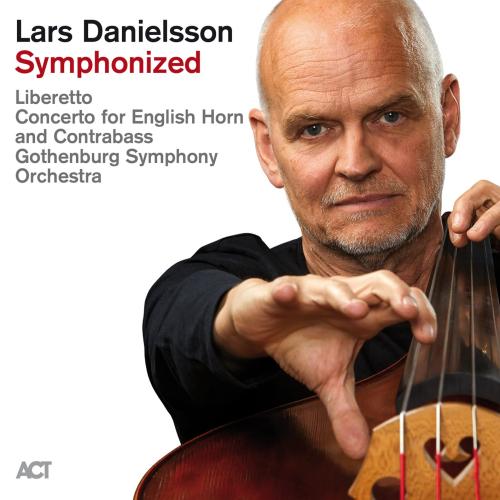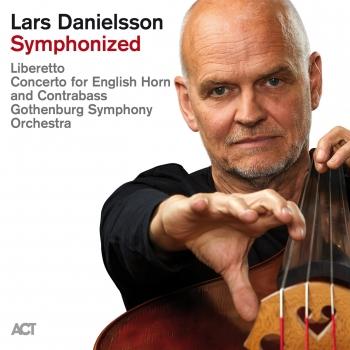
Lars Danielsson Symphonized Lars Danielsson & Gothenburg Symphony Orchestra
Album info
Album-Release:
2023
HRA-Release:
31.03.2023
Label: ACT Music
Genre: Classical
Subgenre: Classical Crossover
Artist: Lars Danielsson & Gothenburg Symphony Orchestra
Composer: Lars Danielsson
Album including Album cover Booklet (PDF)
- Lars Danielsson (b. 1958): Liberetto:
- 1 Danielsson: Liberetto 05:01
- Passacaglia:
- 2 Danielsson: Passacaglia 05:39
- Africa:
- 3 Danielsson: Africa 06:59
- Sacred Mind:
- 4 Danielsson: Sacred Mind 05:19
- Lviv:
- 5 Danielsson: Lviv 04:47
- Nikita's Dream:
- 6 Danielsson: Nikita's Dream 05:41
- The Fifth Grade:
- 7 Danielsson: The Fifth Grade 08:20
- Yes to You:
- 8 Danielsson: Yes to You 04:03
- I. Affettuoso:
- 9 Danielsson: I. Affettuoso 07:23
- II. Elegi:
- 10 Danielsson: II. Elegi 07:50
- Intermedium:
- 11 Danielsson: Intermedium 02:08
- III. Le Bagatelle:
- 12 Danielsson: III. Le Bagatelle 13:37
- IV. Scherzo:
- 13 Danielsson: IV. Scherzo 07:54
Info for Lars Danielsson Symphonized
Swedish bassist/cellist Lars Danielsson is a master improviser, who completely engages listeners by taking them on journeys of both pleasure and wonder, with themes which are always expressive and song-like. He is far too classy and refined a musician to indulge in superficial virtuosic display. Danielsson's well-honed, naturally lyrical improvisational lines remain at the service of the flow of the music, something particularly noticeable when he steps forward and takes on the role of soloist. These core traits are also there in his extensive and much-praised work as arranger, composer and bandleader. With the group he leads, "Liberetto", he has not only found a catchy name for the ideal band to realise his intentions, but also a formula for his approach: the word he has constructed contains "libretto", a pointer towards the composed, quasi-classical nature of his writing, and also a link to opera and lyricism, whereas the Latin word "liber" refers to the freedom of improvisation, a core principle in jazz. And his unique talent is being increasingly recognized: the most recent Liberetto album from 2021, as Downbeat’s Brian Morton noted, “confirms Danielsson’s stature as a leader/composer”.
Classical music and jazz are the two determining poles of Danielsson's musical career. He says – with a smile – that "the question whether I am a jazz musician would be answered with a ‘yes’ from the musicians in the orchestra...but if I were to ask Wynton Marsalis, it would probably be a ‘no’". Danielsson feels comfortable in the space between classical music and jazz. His first music teacher was a church organist, and the folklore of his native Sweden has also been ever-present in his musical identity. As a young cellist, he played a lot in orchestras. His familiarity with Bach and sacred hymns soon broadened into a love of rock 'n' roll, but that faded away in the mid-seventies with the rise of New Wave, and when he began to listen to jazz. Lars Danielsson was always concerned with defining his own place as a European musician out of this mixture of influences. Although he also played jazz standards in the beginning, he kept on searching: "A lot of different experiences have found their way into my music."
With his double album "Symphonized", Lars Danielsson is now fulfilling a dream. Some of the musicians of the Gothenburg Symphony Orchestra were his contemporaries at the conservatoire. In 2008, he recorded his own music with this orchestra for the first time. In 2017 the orchestra’s cor anglais (English horn) player Björn Bohlin was allowed to pick a composer to write for the orchestra, and he commissioned Danielsson: 2018 they played the "Concerto for English Horn and Contrabass" live for the first time, then in 2019 the recording took place, this time with Carolina Grinne as soloist on English horn and oboe. Two years later, the opportunity arose to record extra material at the same location. The idea of a "best-of" project with a difference, with pieces from Liberetto in orchestral form, was born. A full orchestra with 79 members and guest soloists was involved, with Peter Nordahl as conductor for both recordings. Nordahl has made a speciality of projects which combine classical and popular music.
The classical-jazz connection is of course, fraught with danger, something of which Lars Danielsson is very aware. This awareness is precisely what makes the "Symphonized" recordings so effective, because he writes for orchestral musicians in the way they are used to, it doesn't cross his mind to ask them to play jazz. "I hope to know my way around their instruments well enough to be able to write for them in a way that sounds the best possible." A cinematic wide-screen music has emerged, with echoes of Claus Ogermann, Nino Rota or Ennio Morricone, perhaps. And from there it is not too far to thoughts of Maurice Ravel, to whom Claude Debussy once said: "Pleasure is the law."
This pleasure is palpable on the recordings. Supple, with timbres and textures in balance, and full of melodic variety, events unfold in a way which creates enjoyment. Lars Danielsson sees a challenge in using the orchestra in a way that leaves organic space for solo instruments. Melody, flow and emotion are central elements of his art. "My music should sound as beautiful as possible," he says, "but it must also be interesting for the performers who are playing it. They should have fun with my compositions. Writing melodies and then hearing them interpreted by the musicians of an orchestra is total magic. On 'Sacred Mind', for example, I didn't play. I just sat in the hall and enjoyed the stunning sound of the orchestra."
It was in 2004 that Lars Danielsson's successful collaboration with ACT began, and his debut release on the label, the album "Libera Me", featured the Danish Radio Concert Orchestra, augmented by a stellar band: Jon Christensen, Nils Petter Molvær, Jan Bang, Caecilie Norby and others. One could hear that particular sound with its lightness and flow, and with it the invitation to spend a good time in the company of truly excellent musicians. For the time being at least, Danielsson could be said to have come full circle. But this story is such a good one, it must – and will – be continued...
Lars Danielsson, double bass, cello
Grégory Privat, piano
Magnus Öström, drums & percussion
John Parricelli, guitar
Gothenburg Symphony Orchestra
Peter Nordahl, conductor
Carolina Grinne, english horn, oboe d ́amore
Guests:
Arve Henriksen, trumpet (Nikita‘s Dream and Yes to You)
Paolo Fresu, trumpet (Africa and Scherzo)
Lars Danielsson
The late great Danish bass legend Nils-Henning Ǿrsted Pedersen didn’t only leave the world a direct legacy of great jazz through his own playing; a part of what he has bequeathed is indirect. When the young Swedish musician Lars Danielsson once heard him in concert, he was so deeply affected, he turned towards jazz, and to the bass. Until that point, Danielsson, born in Gothenburg in 1958, had been studying classical cello at the conservatory in his home town of Gothenburg. Fortunately, that study of the cello is not something he has chosen to shrug off, he has integrated it into what he does now. Not just in the sense that he always includes the cello in his repertoire, but also that his bass-playing unmistakably has a slightly more melodious, floating and lyrical ring to it than that of many of his fellow bass players.
These were the special qualities which soon placed him in very high demand internationally as a sideman. As early as the 1980s, he had worked not only with local and European greats such as Lars Jansson, Hans Ulrik, Carsten Dahl, Nils Landgren, Christopher Dell, Johannes Enders and Trilok Gurtu (in whose group he remained a member for some time), but also with luminaries of the American scene such as saxophonists Rick Margitza and Charles Lloyd, the Brecker Brothers, drummers Terri Lyne Carrington , Jack DeJohnette and Billy Hart or guitarists John Scofield, Mike Stern and John Abercrombie. But Danielsson has never been content with just an accompanying role. He has always been a creative composer as well and is one of a relatively small group of bassists who has also emerged as a significant bandleader.
The ensemble which gave Danielsson the best outlet in his quest for musical self-expression for almost 20 years was his own all-star quartet with American saxophonist David Liebman (who used to play with Miles Davis), Swedish pianist Bobo Stenson and Norwegian drummer Jon Christensen. Stenson and Christensen are both pioneers of the ”Nordic Sound”, the combination of jazz with the Scandinavian ethos, and both are also long-standing artists on the ECM label. Four albums by the quartet under Danielsson‘s name and six more albums with guests consolidated Danielsson’s reputation as one of Europe’s leading jazz musicians, receiving not just enthusiastic reviews but also many awards. Furthermore, this band laid the foundation for his work as a composer, arranger and producer, which has developed in a major way since then. Danielsson has worked in these capacities with the Danish Radio Concert Orchestra, the Gothenburg Symphony Orchestra, the NDR Big Band, the St. Petersburg Symphony Orchestra and the JazzBaltica Ensemble, the drummer Jonas Johanssen and the singers Viktoria Tolstoy and Cæcilie Norby – the latter being his wife, whom he regularly accompanies.
In the past few years, Lars Danielsson has also expanded his musical frame of reference and stylistic range of his own projects. His ACT debut, ”Libera Me” from 2004, proved him to be a master of orchestral jazz. ”Mélange Bleu”, two years later, sprung a surprise with a modern, carefully applied electronic framework for his expansive and sonically adventurous and rich compositions. With ”Pasodoble” in 2007, he created a breathtaking manifesto of beautiful sound in a duet with the Polish pianist Leszek Możdżer, which occupied the terrain between classical music and jazz, and received superb reviews. ”Tarantella” continued the productive collaboration with Możdżer in 2009, but transferred the basic musical idea into the context of a chamber jazz ensemble. All these albums (as well as those that followed) went either gold or platinum, and the orchestral project ”Blauklang”, co-initiated by him and conducted by Vince Mendoza, was nominated for a Grammy.
To some extent, Danielsson really found the quintessence of his diverse forms of expression in 2012 – and also the right name for it: ”Liberetto”. His newly-created word ”describes a certain mood in which I want to develop my music,“ he says. ”It follows on from my earlier albums – purely linguistically as in the reference to classical music.” The album, itself entitled ”Liberetto” with the Armenian star pianist Tigran, e.s.t. drummer Magnus Öström, British guitarist John Parricelli and trumpeter Arve Henriksen found a new balance between jazz, classical music, pop and European folk music and thus opened up a new dimension of how compositional processes and dramaturgy could be used in jazz. It was so successful that the project continues to this day: After ”Liberetto II” in a very intimate duo with Tigran and ”Liberetto III” in the tried and tested quartet, with the addition of a new and different hue in the form of French-Caribbean pianist, Grégory Privat, Danielsson performed a symphonic version of this concept and the compositions for it at the Leopolis Jazz Fest. There will also be a recording of this project in the near future.
Naturally, Danielsson also leaves plenty of room for other interesting projects: he participates in the unique concert series ”Jazz at Berlin Philharmonic”, and he works in a duo with the Sardinian trumpeter Paolo Fresu, one of the most lyrical players anywhere. Their joint album ”Summerwind” is the latest proof of what makes Danielsson quite so special: technical brilliance, a vivid and consistently fertile musical imagination, and an almost telepathic understanding with other musicians.
Booklet for Lars Danielsson Symphonized










